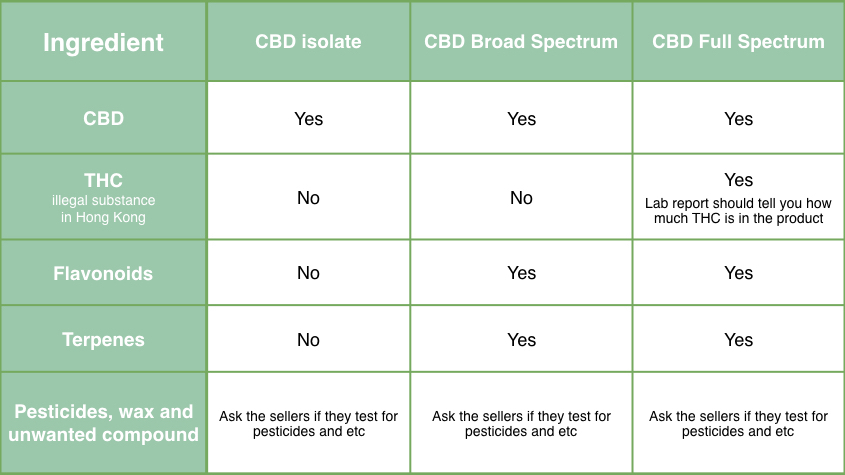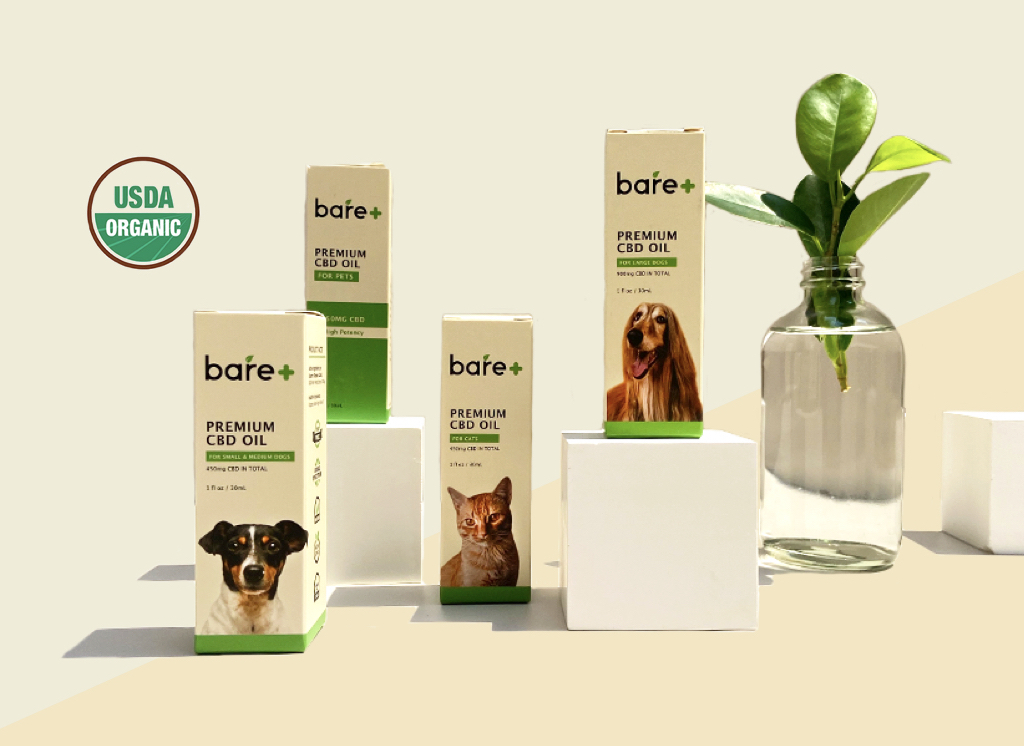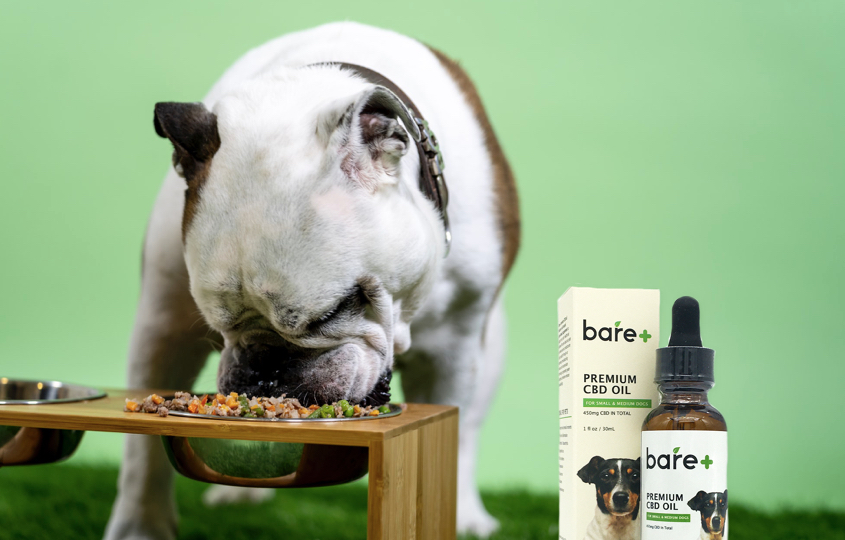Interested in natural supplements for your pets? Is your pet is sometimes anxious or nervous? Does your pet suffer from joint pain, skin problems, seizure, cancer or sleeplessness? If so, you should get yourself educated on plant-powered Cannabidiol (CBD) derived from hemp plants. We always seek for knowledge and tips on keeping our furry friends healthy, so we round up some facts, potential benefits, application guide and possible risks of this increasingly popular supplement for pets.
1. First thing first: what is CBD?
You might not have heard about CBD, but it’s been trending around the globe. More and more veterinarians incorporate CBD oil into treatment (we are talking about holistic veterinarians who don’t just prescribe you strong western medicine, but believe in the power of integrative and less invasive approach including acupuncture, homeopathy, diet and nutrition…). CBD stands for cannabidiol, one of the hundreds of ingredients in cannabis derived from hemp plant. Hemp is often confused with marijuana (with THC as the responsible psychoactive compound) hence the stigma surrounding CBD. The fact is that CBD is natural and non-intoxicating, there’s no way to “overdose” and make you or your pets “high”, plus it’s legal to buy it.
2. Potential benefits for pets?
Fact: all mammals have an endocannabinoid system in their bodies. It’s a complex biological system that impacts and regulates several major processes including immune responses, appetite, digestion, movement, pain, metabolism, sleep and mood. Cannabinoids bond with brain receptors to increase the body’s own ability to achieve wellness. They help maintain dynamic balance, keeping cells in the best working condition. On the other hand, loss of dynamic balance can cause dysfunction of the body and weaken immune system, resulting in many diseases.
Most pet owners use CBD products for:
◆ Anxiety, stress, depression (for example, your dog is scared of car ride, out and about, thunder, being around new people and dogs…)
◆ Appetite loss
◆ Joint problems, arthritis, osteoarthritis, hip dysplasia
◆ Pain management (for example, post-surgery pain management. severe · stomach upset, cancer, ear or skin or urinary tract infection, soft tissue injury…)
◆ Seizures
◆ Skin problems
3. Is CBD safe for dogs and cats?
Yes. As per the World Health Organisation (WHO), CBD is deemed a safe and non-toxic substance. Overdosing on CBD is virtually impossible. Also, National Center for Biotechnology Information (NCBI) in the US has conducted a study in 2019 regarding to the effect of oral CBD products taken by dogs and cats and it confirmed relative safety of oral supplementation.
4. Terminology for CBD: What is isolate, broad spectrum and full spectrum? And why you should care?
You need to know about this if you are considering CBD products for yourself and your pets. CBD Isolate is typically 99% CBD and nothing else, excluding any other ingredients like THC, flavonoids and terpenes. Unlike Isolate, Full Spectrum refers to CBD extracts that contain all other compounds and cannabinoids including THC that might cause legal complication in Hong Kong. Broad Spectrum is more of a hybrid of Isolate and Full Spectrum CBD, it has the effectiveness of Full Spectrum and retains flavonoids, terpenes and other beneficial phytocannabinoids (this is what we call “entourage effect” – cannabinoids working together to ensure that you get the best health benefits possible from CBD). And best of all, Broad Spectrum contains no THC to get your pet “high”. Bare+ that we’ve tried is Broad Spectrum CBD which is widely recommended by professionals. It’s made in the US and independently tested by third party laboratory to prove CBD potency and free of THC, microbial, heavy metal and over 60 types of pesticides. The product packaging shall make it very clear, but when in doubt, you should ask the sellers what their CBD is. 
5. Product review from customers?
Bare+ CBD dog treats and oil tinctures have caught our attention, so we’ve invited our pet models (12-year-old poodle and 6-year-old Shiba) to try these products. The poodle always has a bit of joint problem and sometimes suffers from pain and loss of appetite. He has been fed with 1/4 dropper of Bare+ CBD Oil for Small & Medium Dogs two times a day in the morning and at night, and when pain occurs, the dose is higher to 1/3 dropper of the oil. The pet owner is glad to see positive changes in him gradually after 5 weeks of usage. The shiba is happy and energetic, sometimes nervous during outing. The owner feeds her two treats 30 minutes before going out to take a ride and grooming. CBD shall help him relax more, and he loves the treat and often wants more.
6. How to feed CBD to my pet?
If it’s treat, then it’s easy, just feed according to the recommended consumption listed on the product package. If it’s CBD oil, you can either 1) insert the oil dropper in your pet’s mouth and squeeze the dropper. Right afterwards, you can give them their favourite treat so they don’t start getting scared of the sight of your CBD oil bottle, or
2) if the above doesn’t work, you can simple mix the CBD oil into your pet’s food.
7. How much CBD oil should I give to my pet?
We wish there’s a simple answer for this. In principle, the CBD dose shall base on 1) your pet weight, 2) the purpose of using CBD e.g. the dose for more severe condition such as seizure or post surgery recovery is higher than for overall wellness and nervous behaviour, 3) the CBD potency of your CBD oil tincture plus the quality of the oil. Usually the manufacturers have clear information about recommended dose on the product packaging. You can easily reach Bare+ team via WhatsApp (852) 5915 1405 when in doubt on how to choose CBD products and suggested dose. Because all pets metabolise CBD differently and can respond differently, and because quality of different CBD brands and hence bioavailability of the products vary, you should monitor your pet’s reaction for a couple of hours after consumption. Ultimately, it is absolutely normal to take a few attempts to find the ideal dosage for your individual pet, and more than 4 to 7 weeks to see noticeable results.
8. How long does it take for CBD to kick in?
CBD usually takes 30 to 45 minutes to start working. Oils tend to kick in a little faster than treats just because there are fewer ingredients for pets to break down first. No difference in effectiveness between oil and treats.
9. Can CBD oil or treats be mixed with prescribed medications?
To play safe, it is usually recommended to take CBD and prescribed drugs 2 hours apart.
10. How to compare different CBD brands and products?
We want to be smart and educated consumers. When comparing different products, the following factors are worth considering:
Price:
If you look at only the prices but fail to take account of the potency of CBD contained in the oil, then you are wise enough. For example: the total CBD potency of CBD oil of Brand A is 300mg with the price tag of $550, that is, the price per mg is $1.83/mg ($550 / 300mg). For Brand B, the total CBD potency of oil is 450mg CBD and the price is $620, that is, the price per mg is $1.38/mg ($620 / 450mg). In a glance, Brand A looks cheaper, but in fact Brand B has a higher value for price.
Quality:
How to judge the product quality? We shall check whether the product has been tested by an independent laboratory to prove the accuracy of CBD potency with no THC, microbial, heavy metals and pesticides (in the lab report, when these compounds are below > Limit of Detection (LOD), it means that they are not there in the product sample). For those who care about organic, check if there’s an organic label on it. Organic usually comes with a higher cost though which is understandable. Also, an important metric of judging product quality, yet unfamiliar to many, is bioavailability. According to clinical observation and measurement in the past two decades, it has been found that with the same dosage of various wellness products (or drugs), the efficacy is not the same. Bioavailability refers to the ability of a substance to be absorbed and used by the body. How much (how bioavailable) CBD of a product depends on many factors including but not limited to the form of the CBD product, manufacturing technology, hemp extraction method and etc.
Product manufacturing technology:
To enhance the bioavailability, and hence the value, of CBD supplements requires manufacturers to make CBD water soluble. If CBD is not soluble in water, our and animals’ bodies will not be able to absorb and make use of the substance. This is because the body is mainly composed of water, and if the substance cannot be effectively dissolved in water, it will be difficult for CBD to be processed and absorbed to achieve the expected efficacy. The manufacturer of Bare+ openly discloses its product manufacturing process and technology used (listed on its website) and we’ve got to ask more. As we know the importance of making CBD water soluble, we learned that theirs is. They use nanotechnology to break CBD oil into tiny particles to be water soluble. Also supercritical carbon dioxide (CO2) hemp extraction method is used to ensure that beneficial phytocannabinoids, terpenes and flavonoids are retained in the process. This causes no damage on CBD while all good stuff is kept. This extraction method is commonly used in food and drug manufacturing process. When you are shopping for CBD supplements, it’s smart to learn about not only its product of origin, but most importantly its manufacturing technology in order to tell if the products are of high quality or not. 
11. Any evidence or research to back up the efficacy of CBD?
Idiopathic epilepsy, which occurs with no known cause, is affecting up to 5.7% of the pet dog population worldwide, making it the most common canine neurologic condition. Dr Stephaine McGrath, a neurologist at Colorado State University’s James L. Voss Veterinary Teaching Hospital, found that 89 percent of dogs who received CBD in the clinical trial had a reduction in the frequency of seizures, from a pilot study to access the use of CBD for dogs with epilepsy*. Also, Cornell University’s College of Veterinary Medicine’s clinical trial on the effect of oral CBD oil for pain management for dogs suffering osteoarthritis** is promising. This study revealed dog subjects showed a significant decrease in pain and increase in activity with CBD oil, while no side effects were reported.
12. Potential risk and side effect?
CBD is legal and not classified as a dangerous drug in Hong Kong. Hemp has been used as a wellness tool for thousands of years in China, and as of today, there has been no reported case on CBD poisoning or death from overdose. No long term side effect has been reported but mild side effect includes dry mouth, diarrhea, lowered blood pressure and drowsiness.
* CBD clinical trial results on seizure frequency in dogs ‘encouraging’, 21 May 2019 by Colorado State University
** Pharmacokinetics, Safety, and Clinical Efficacy of Cannabidiol Treatment in Osteoarthritic Dogs
Hellodog does not provide medical advice, diagnosis or treatment. See more details here.

Comments are closed here.